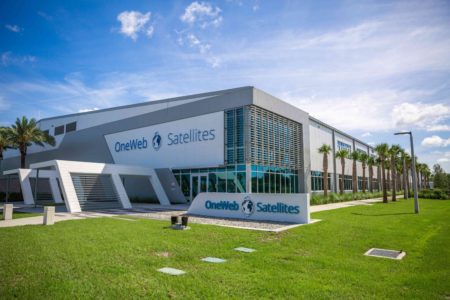July 22, 2019 – When NASA builds a satellite, the manufacturing process is painstakingly slow, often years before the finished product is built, tested, and then readied for launch. Even in the period when NASA began their faster, better. cheaper phase, from concept to completion took the Agency at least a year from concept to launch. In total, 16 missions were launched between 1996 and 1999 with 6 failures. The bulk of the failures occurred near the end of that period which eventually led to a rethink by the Agency in its build processes.
Well faster, better, cheaper, is making a comeback, but not from NASA. A joint venture announced today, between OneWeb, a U.K. company, with a goal to deliver Internet access everywhere through a constellation of low-Earth orbit satellites, and Airbus, the principal rival of Boeing in the field of aeronautics and aerospace, describes “the world’s first high-volume, high-speed advanced satellite production facility.”
It is the first of its kind, an industrial-scale production line for satellites capable of high-speed assembly without sacrificing quality and delivering the products at a fraction of the cost of NASA and any other satellite builder in the market today. The first products to come out of this facility will form the OneWeb telecommunications network with a minimal deployment of 650 satellites and growing to 1,980 when fully completed. The facility is located in Florida near the Kennedy Space Center and features two production lines. It will employ 250 directly and provide an additional 3,000 indirect jobs within the satellite supply chain.
OneWeb is in a new space race to deploy a constellation of satellites for Internet connectivity across the planet. Its principal competitors include SpaceX and Amazon, with lesser competition from Iridium, Telesat, and LeoSat, companies that are also ramping up to make the web accessible to all 7.5 billion of us.
The OneWeb-Airbus project is not alone. SpaceX has plans to open a high-speed production facility for the estimated 7,500 to 12,000 Starlink constellation satellites it proposes to build and deploy. And Amazon’s Jeff Bezos has launched Kuiper Systems LLC, with plans to build and deploy more than 3,000 satellites in its global telecommunications network.
But for now, the OneWeb-Airbus alliance is first out of the gate and here are some details on its production facility and the satellites it intends to produce:
- The facility has two assembly lines, each designed to produce one finished satellite per day. Compare that to today’s standard of a single satellite per year and you can see just how disruptive this new paradigm will be.
- The cost to produce will be 1/50th that of current satellite manufactured products.
- Each completed satellite will weigh 60 kilograms (132 pounds) with total launch mass equaling 150 kilograms (360 pounds).
- The satellites are individually powered by Xenon Hall-effect ion thrusters.
- Design life for each is 7+ years when deployed at 500 kilometers (approximately 310 miles) low-Earth orbit, and 5+ years at a 1,200 kilometers (approximately 745 miles).
Upon completion of the OneWeb constellation the joint venture plans to make its facility available for mass production of third-party satellites. And just as SpaceX has disrupted launch industry costs through reusability, OneWeb and Airbus will very much do the same for satellites through a new mass-production paradigm.















